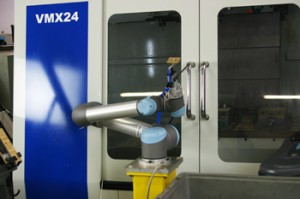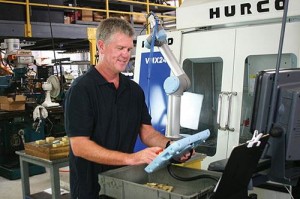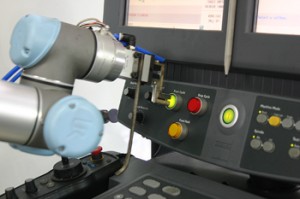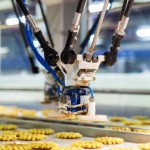Cobots help to meet production challenge
 “The whole premise of our company is to bring manufacturing back to this country,” says Geoff Escallette, CEO of US based RSS Manufacturing and Phylrich, a highly specialised short run production facility which manufactures plumbing fixtures and fittings with turnaround time as quick as 24 hours. “Collaborative robots from Universal Robots fit perfectly with that master plan.”
“The whole premise of our company is to bring manufacturing back to this country,” says Geoff Escallette, CEO of US based RSS Manufacturing and Phylrich, a highly specialised short run production facility which manufactures plumbing fixtures and fittings with turnaround time as quick as 24 hours. “Collaborative robots from Universal Robots fit perfectly with that master plan.”
When the company won a new monthly order to produce 700 valves, it faced a real production challenge. “Our CNC machine can normally do 400 valves per month with two shifts, so we would have been forced to buy another machine even if we put a third shift on,” says Escalette. Instead, though, the company invested in a UR5 collaborative robot. RSS put the robot to work 24/7 and met the order in 11 days while opening up 30 percent more capacity on existing machinery.
“In a flexible environment like this, you need a flexible robot. One that can work without safety cages, one that is portable, and one that can be reprogrammed quickly,” says Escalette.
 RSS has put the UR5 to work with a Hurco CNC machine and a mandrel tube bender. Before deploying the UR5, RSS automation and integration specialist Shane Strange put it through safety assessments, using various accelerations and joint speeds, running the UR5 up against people’s hands to test how much force it would actually take to fail out the robot.
RSS has put the UR5 to work with a Hurco CNC machine and a mandrel tube bender. Before deploying the UR5, RSS automation and integration specialist Shane Strange put it through safety assessments, using various accelerations and joint speeds, running the UR5 up against people’s hands to test how much force it would actually take to fail out the robot.
“The robot is surprisingly sensitive to outside force and will immediately stop when colliding with a person. That enabled us to run it without safety cages,” says Strange.
Employees tend to the machine occasionally to load additional parts for milling and bending while the robot is in action. When the UR5 was deployed to feed tubes into a mandrel tube bender, the RSS team was in for a surprise: “We had not expected the robot to be able to operate so fast. It pushed the limits of the mandrel bender so much that hydraulics in the bender overheated and started to malfunction,” says Escalette. “But it did produce 1500 pieces in four hours. It would have taken us two to three days to accomplish with manual labour. Now, we’ve optimised the bender to keep up with the robot.”
Implementation and training
Setting up the robot took 45 minutes, including unpacking, mounting and programming the first simple pick and place moves. It took RSS a total of eight hours to create the complete setup including all tooling.
 “I’ve worked with other robotic models in the past, and it’s one thing to say it’s easy to program a robot, quite another to integrate it into a real application,” says Strange. “With the UR it really was easy. If you can write a to-do list, you can program this robot.”
“I’ve worked with other robotic models in the past, and it’s one thing to say it’s easy to program a robot, quite another to integrate it into a real application,” says Strange. “With the UR it really was easy. If you can write a to-do list, you can program this robot.”
He continues: “The tablet interface is one of the most significant benefits of the UR robot from a programming stand point. By actually being right there with the robot, troubleshooting as you go saves time from programming at another location.”
Escalette adds: “We’ve had no external costs to speak of as the robot operates with no safety guarding. In terms of end-effectors, you don’t need fancy fixtures, you just need to think outside the box.”
Visit the Universal Robots website for more information.
See all stories for Universal Robots
















